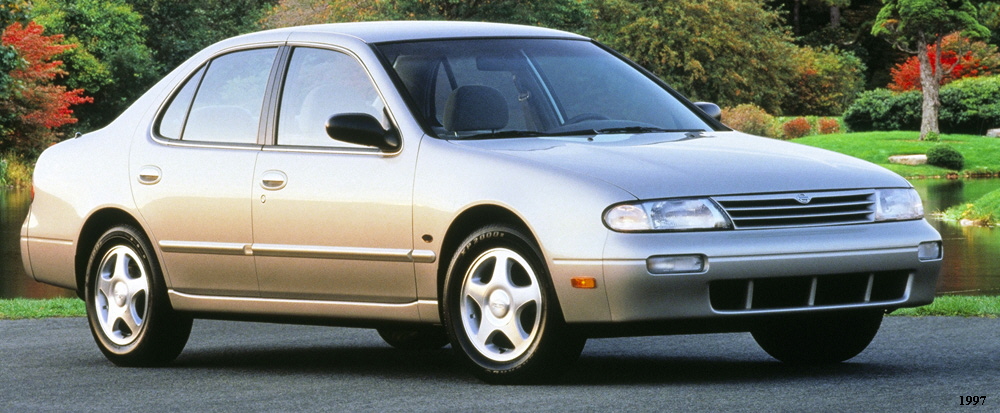
First Generation (1993-1997)
The name “Altima” originally referred to a trim line of the Nissan Laurel mid-size car sold in Central America and the Caribbean before 1992. In 1993, Nissan discontinued the Stanza line, replacing it with the U.S.-made Altima. The very first Altima rolled off the assembly line in Smyrna, Tenn., in June 1992, as a 1993 model. All Altimas were built in Smyrna until June 2004, when Nissan’s Canton, Miss., plant began producing additional Altimas to meet high demand.
Initially, the car’s official name was “Stanza Altima.” 1993 models can be seen with a sticker reading “Stanza” in small lettering to the left of the ALTIMA emblem on the trunk lid. Though the Stanza name was there more for regulatory compliance than a lack of confidence in renaming the middle vehicle in Nissan’s longstanding Sentra-Stanza-Maxima three-sedan lineup, there were concerns at the time about the public’s acceptance and ability to pronounce the new Altima name – enough that guidelines were distributed explaining the proper syllable emphasis. The concern was ill-founded, as Altima had an almost immediate impact on the mid-size sedan segment, which at the time was dominated by the Honda Accord and Toyota Camry.
All Altima models used Nissan’s 150 hp straight-4 DOHC engine mated to a 5-speed manual or 4-speed automatic. Suspension was composed of struts with stabilizer bars at both ends and was noted for providing sporty, satisfying handling. Trim lines consisted of the entry level XE, mid-line GXE, sporty SE, and luxury GLE.
The base XE (rare) had manual windows. The mid-line GXE had power windows, a power retracting antenna, pass thru rear armrest, digital clock in dash, and color matched plastic speaker grilles for the rear 6-inch speakers. The XE and GXE models only had the fixed intermittent wiper switch.
In addition to the GXE features, the SE had a stiffer suspension, fog lights, 3-leg mount rear spoiler, side skirts and sport seats (plus a standard sunroof in 1994-1995). It also had 4-wheel disc brakes, which came on the other trim lines when antilock brakes were ordered.
The GLE’s enhancements included a digital head-up display (1993 and 1994 only), which displayed speed in mph or km/h, turn signals, and various warning lights on a unique mirrored patch made into the windshield. Other features included a coin holder built into the fuse panel cover (1993 and 1994 only), adjustable lumbar support on the front seats, automatic digital climate control, keyless entry with alarm (optional), floor mats, color matched side mirrors, cornering lights, sunroof, and a higher-powered six-speaker cassette/CD stereo which included 6X9 rear speakers with black metal “active speaker” grilles. For 1997 it gave up all of the above in exchange for standard leather (previously optional). All SE and GLE models had alloy wheels and variable intermittent wipers.
The 1993 Altima came with a rosewood colored dash trim and only had a driver’s side airbag coupled with automatic shoulder belts. The 1994 Altima gained a darker burl wood dash trim, a flush mount passenger airbag and regular seatbelts. The 1995 model year also brought a new venetian blind-like grille, new taillights (red and clear), and a new 2 leg mount spoiler with a red LED brake light for the SE. Nissan added new wheel covers for base models in 1996. In 1997 the GXE gained a new “Limited Edition” package including alloy wheels, keyless entry, alarm, floor mats, and a Limited Edition sticker on each side near the front wheels. The majority of final-year Altima models were dubbed “1997.5” models, signifying the added crash protection necessary to meet 1997 side-impact standards.

You must be logged in to post a comment.